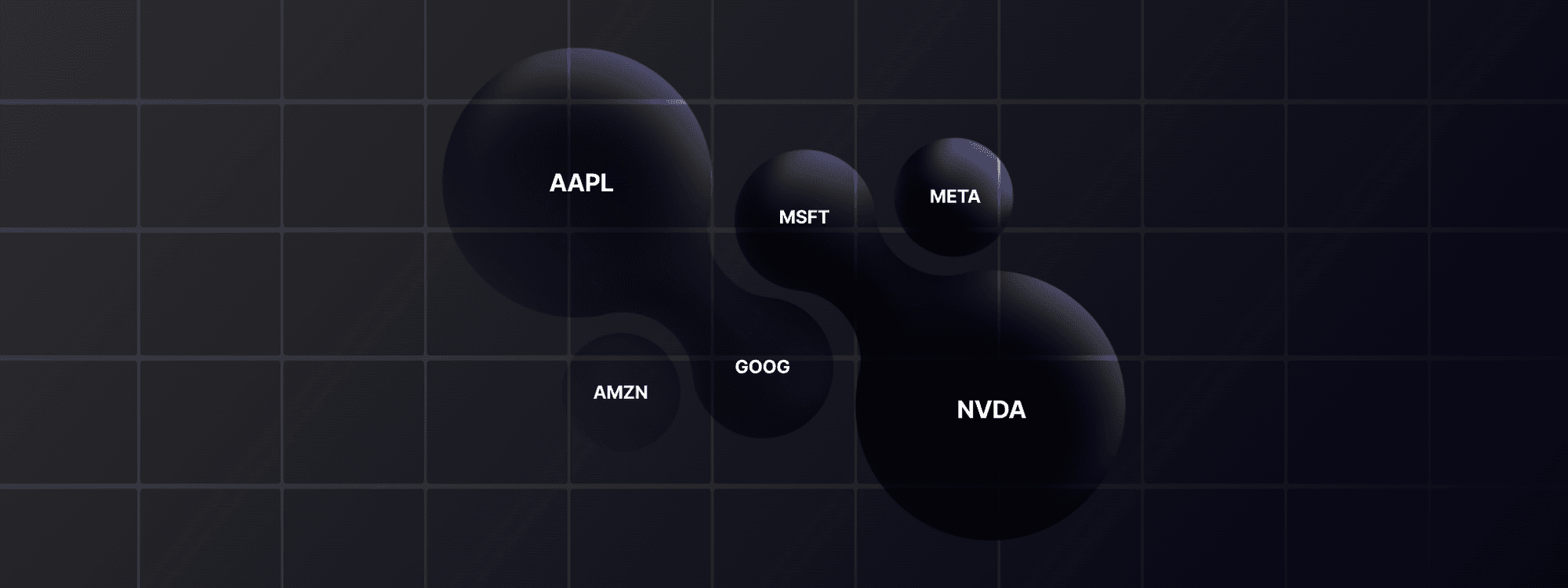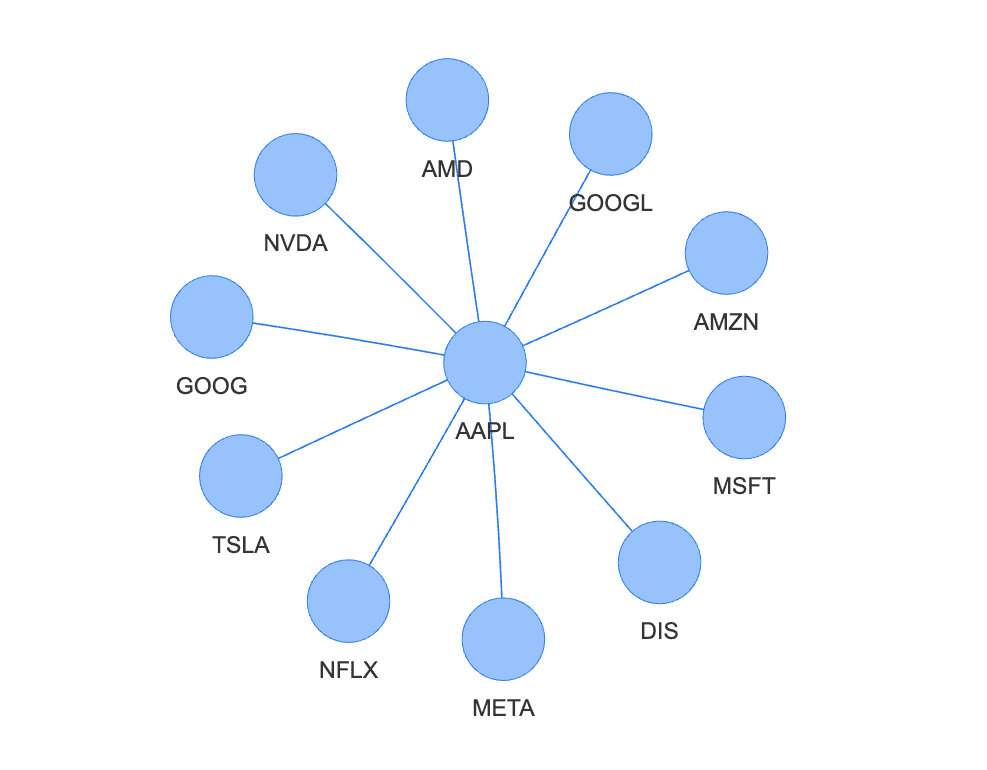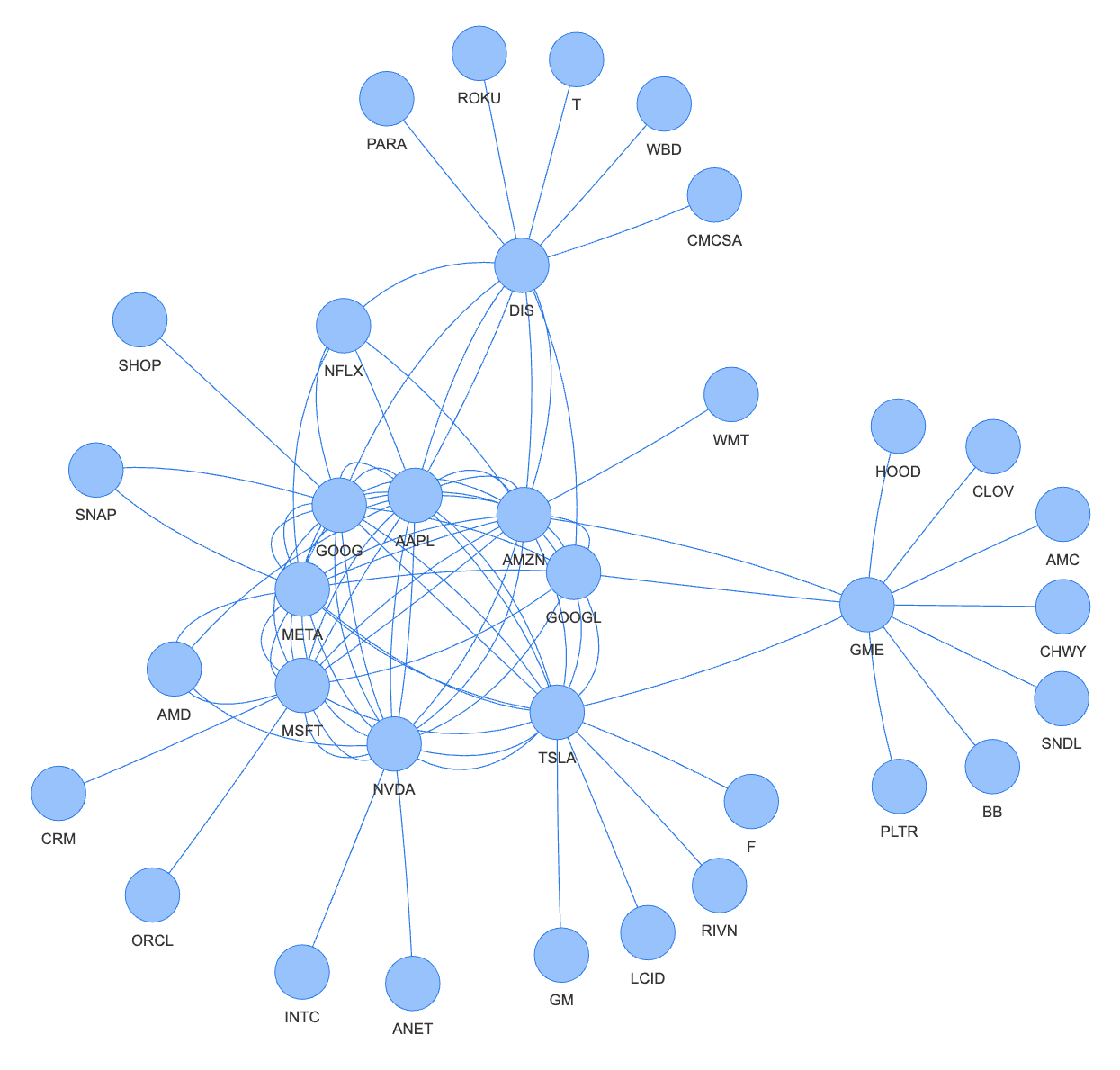
Polygon.io is Now Massive
Polygon.io is now Massive.com. The rebrand reflects our focus on scale, reliability, and continued innovation. Your APIs, accounts, and integrations continue to work without interruption.
editor

Introducing
Aug 1, 2024
In this tutorial, we'll examine the newly released Related Companies API, designed to identify relationships between companies using data from news articles and financial returns data. We will look at the API's functionality by retrieving data for common stocks and visualizing these relationships using Python and vis.js.
The Related Companies API can help you discover relationships between companies that might span across multiple sectors such as technology, semiconductors, media, and many others. Beyond the obvious connections, this API can reveal subtle relationships often mentioned in news articles or financial data where companies from different sectors are mentioned together.

Let's start with a simple example to learn about these relationships. To get started, you'll need an API key, which can be obtainable upon signing up with Polygon.io. For this example, we'll use Python and the Polygon.io client-python library. Here’s how to retrieve the 10 companies most closely related to Apple:
from polygon import RESTClient client = RESTClient() related_companies = client.get_related_companies("AAPL") print(related_companies)
This script then outputs the 10 most related companies to the AAPL ticker provided. Behind the scenes, we look at how often these companies are talked about together in news articles and financial data and then calculate a ranking. So, we provided the ticker symbol
$ python examples/rest/stocks-related_companies.py [ RelatedCompany(ticker="MSFT"), RelatedCompany(ticker="GOOGL"), RelatedCompany(ticker="AMZN"), RelatedCompany(ticker="GOOG"), RelatedCompany(ticker="TSLA"), RelatedCompany(ticker="NVDA"), RelatedCompany(ticker="META"), RelatedCompany(ticker="NFLX"), RelatedCompany(ticker="DIS"), RelatedCompany(ticker="BRK.B"), ]
Now that you know the basics of the Related Companies API, let's try and fetch some common tickers, and then visualize this data, just to highlight some of the strong links between these companies.
In this section, we will build on what we know already to construct a network graph to visualize the relationships between companies. Let’s start with the "Magnificent 7", those being Microsoft, Amazon, Meta, Apple, Alphabet, Nvidia, and Tesla. These companies are probably best known for their significant market performance, competition between each other, and frequent mentions in various contexts. By using vis.js, we can create dynamic graphs where each node represents a company, and the edges illustrate the strength and nature of their relationships.
This script retrieves related companies, then creates a network of
from polygon import RESTClient import json def get_related_tickers(): client = RESTClient(trace=True) # Fetch a limited list of tickers to keep the example manageable main_tickers = ["MSFT", "AMZN", "META", "AAPL", "GOOG", "NVDA", "TSLA", "HCP", "GME", "DIS"] # Prepare data structures for nodes and edges nodes = [] edges = [] id_map = {} current_id = 1 # Iterate over each main ticker and find related tickers for ticker in main_tickers: if ticker not in id_map: id_map[ticker] = current_id nodes.append({'id': current_id, 'label': ticker}) current_id += 1 related_companies = client.get_related_companies(ticker) for company in related_companies: related_ticker = company.ticker if related_ticker not in id_map: id_map[related_ticker] = current_id nodes.append({'id': current_id, 'label': related_ticker}) current_id += 1 edges.append({'from': id_map[ticker], 'to': id_map[related_ticker]}) # Save the nodes and edges to a JSON file for web visualization with open('data.json', 'w') as f: json.dump({'nodes': nodes, 'edges': edges}, f) if __name__ == "__main__": get_related_tickers()
The generated JSON file structures the data into two arrays:
{ "nodes": [ {"id": 1, "label": "MSFT"}, {"id": 2, "label": "AMZN"}, {"id": 3, "label": "GOOGL"}, ... ], "edges": [ {"from": 1, "to": 2}, {"from": 1, "to": 3}, ... ] }
Each
To render the graph, we'll use a basic HTML structure using vis.js using an example from here. Below is a simplified version of the HTML file, where you can add arrays for
<!DOCTYPE html> <html lang="en"> <head> <title>Vis Network | Related Companies</title> <style type="text/css"> #mynetwork { width: 2400px; height: 1200px; border: 1px solid lightgray; } </style> <script type="text/javascript" src="https://unpkg.com/vis-network/standalone/umd/vis-network.min.js"></script> <script type="text/javascript"> var nodes = null; var edges = null; var network = null; function draw() { nodes = [{"id": 1, "label": "MSFT"}, {"id": 2, "label": "GOOGL"}, {"id": 3, "label": "NVDA"}, {"id": 4, "label": "AMZN"}, {"id": 5, "label": "GOOG"}, {"id": 6, "label": "META"}, {"id": 7, "label": "TSLA"}, {"id": 8, "label": "AAPL"}, {"id": 9, "label": "CRM"}, {"id": 10, "label": "ORCL"}, {"id": 11, "label": "AMD"}, {"id": 12, "label": "NFLX"}, {"id": 13, "label": "WMT"}, {"id": 14, "label": "DIS"}, {"id": 15, "label": "SNAP"}, {"id": 16, "label": "SHOP"}, {"id": 17, "label": "INTC"}, {"id": 18, "label": "ANET"}, {"id": 19, "label": "RIVN"}, {"id": 20, "label": "GM"}, {"id": 21, "label": "F"}, {"id": 22, "label": "LCID"}, {"id": 23, "label": "GME"}, {"id": 24, "label": "AMC"}, {"id": 25, "label": "HOOD"}, {"id": 26, "label": "BB"}, {"id": 27, "label": "CHWY"}, {"id": 28, "label": "CLOV"}, {"id": 29, "label": "PLTR"}, {"id": 30, "label": "SNDL"}, {"id": 31, "label": "WBD"}, {"id": 32, "label": "CMCSA"}, {"id": 33, "label": "PARA"}, {"id": 34, "label": "T"}, {"id": 35, "label": "ROKU"}]; edges = [{"from": 1, "to": 2}, {"from": 1, "to": 3}, {"from": 1, "to": 4}, {"from": 1, "to": 5}, {"from": 1, "to": 6}, {"from": 1, "to": 7}, {"from": 1, "to": 8}, {"from": 1, "to": 9}, {"from": 1, "to": 10}, {"from": 1, "to": 11}, {"from": 4, "to": 1}, {"from": 4, "to": 2}, {"from": 4, "to": 5}, {"from": 4, "to": 8}, {"from": 4, "to": 7}, {"from": 4, "to": 3}, {"from": 4, "to": 6}, {"from": 4, "to": 12}, {"from": 4, "to": 13}, {"from": 4, "to": 14}, {"from": 6, "to": 5}, {"from": 6, "to": 2}, {"from": 6, "to": 1}, {"from": 6, "to": 4}, {"from": 6, "to": 8}, {"from": 6, "to": 7}, {"from": 6, "to": 3}, {"from": 6, "to": 15}, {"from": 6, "to": 12}, {"from": 6, "to": 11}, {"from": 8, "to": 1}, {"from": 8, "to": 2}, {"from": 8, "to": 4}, {"from": 8, "to": 5}, {"from": 8, "to": 7}, {"from": 8, "to": 3}, {"from": 8, "to": 6}, {"from": 8, "to": 12}, {"from": 8, "to": 14}, {"from": 8, "to": 11}, {"from": 5, "to": 2}, {"from": 5, "to": 1}, {"from": 5, "to": 6}, {"from": 5, "to": 4}, {"from": 5, "to": 8}, {"from": 5, "to": 7}, {"from": 5, "to": 3}, {"from": 5, "to": 15}, {"from": 5, "to": 12}, {"from": 5, "to": 16}, {"from": 3, "to": 11}, {"from": 3, "to": 6}, {"from": 3, "to": 2}, {"from": 3, "to": 7}, {"from": 3, "to": 5}, {"from": 3, "to": 1}, {"from": 3, "to": 8}, {"from": 3, "to": 4}, {"from": 3, "to": 17}, {"from": 3, "to": 18}, {"from": 7, "to": 19}, {"from": 7, "to": 2}, {"from": 7, "to": 4}, {"from": 7, "to": 20}, {"from": 7, "to": 21}, {"from": 7, "to": 22}, {"from": 7, "to": 5}, {"from": 7, "to": 6}, {"from": 7, "to": 8}, {"from": 7, "to": 3}, {"from": 23, "to": 24}, {"from": 23, "to": 7}, {"from": 23, "to": 25}, {"from": 23, "to": 26}, {"from": 23, "to": 27}, {"from": 23, "to": 28}, {"from": 23, "to": 4}, {"from": 23, "to": 29}, {"from": 23, "to": 2}, {"from": 23, "to": 30}, {"from": 14, "to": 12}, {"from": 14, "to": 31}, {"from": 14, "to": 4}, {"from": 14, "to": 32}, {"from": 14, "to": 33}, {"from": 14, "to": 8}, {"from": 14, "to": 2}, {"from": 14, "to": 34}, {"from": 14, "to": 5}, {"from": 14, "to": 35}]; var container = document.getElementById("mynetwork"); var data = { nodes: nodes, edges: edges }; var options = { nodes: { shape: 'dot' } }; network = new vis.Network(container, data, options); } </script> </head> <body onload="draw()"> <div id="mynetwork"></div> </body> </html>
After setting up the HTML as described and replacing the placeholder data with actual network data, you will be able to visualize the relationships between companies as an interactive network graph by opening the file in your web browser.

Try modifying the source tickers in the Python script, regenerate and copy over the data, then observe how the network changes. This example goes beyond the new Related Companies API but hopefully gives you some ideas on what you could build and how to create a visually appealing and interactive graph that helps you understand complex relationships between companies.
In this tutorial, we've explored the capabilities of the newly released Related Companies API from Polygon.io, which provides a robust tool for identifying company relationships through news and financial data.
The examples provided, particularly the Python script to fetch related companies, highlight the API’s practical application and ease of integration. The visualization with vis.js serves as an additional demonstration of how you might utilize the data in a dynamic format. We encourage you to dive into the API, integrate it with your projects, and leverage its insights to enhance your data-driven analyses. For more detailed examples and to access the complete codebase, visit our GitHub repository.
Happy exploring!
Justin
editor
See what's happening at polygon.io

Polygon.io is now Massive.com. The rebrand reflects our focus on scale, reliability, and continued innovation. Your APIs, accounts, and integrations continue to work without interruption.
editor

Effective Nov 3, 2025, bid_size/ask_size will be reported in shares (not round lots) across Stocks Quotes REST API, WebSocket, and Flat Files, per SEC MDI rules. The rule is forward-looking and we’ll also backfill history for consistency. Most users need no changes.
editor

Learn how to use Massive's MCP server inside of a Pydantic AI agentic workflow, alongside Anthropic's Claude 4 and the Rich Python library.

alexnovotny